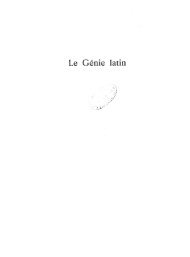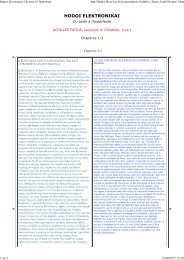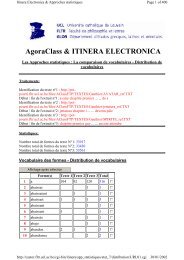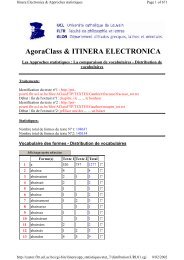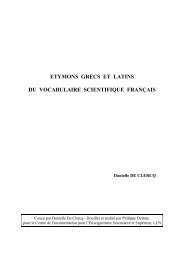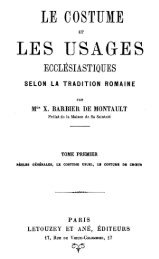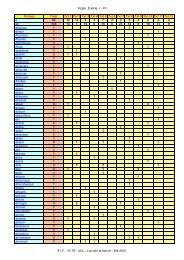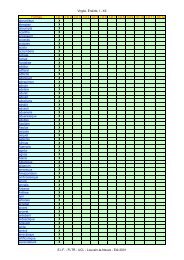The Etymologies of Isidore of Seville - Pot-pourri
The Etymologies of Isidore of Seville - Pot-pourri
The Etymologies of Isidore of Seville - Pot-pourri
Create successful ePaper yourself
Turn your PDF publications into a flip-book with our unique Google optimized e-Paper software.
to establish educational centers at each cathedral city<br />
<strong>of</strong> Spain. Bishop Braulio’s claims that the <strong>Etymologies</strong><br />
were written at his own request (Letter II and Renotatio)presume<br />
a clerical motive, and Braulio’s sense <strong>of</strong> the<br />
<strong>Etymologies</strong>’ purpose is to the point: “Whoever thoughtfully<br />
andthoroughlyreadsthroughthiswork...willnot<br />
be ignorant <strong>of</strong> the knowledge <strong>of</strong> human and divine matters,<br />
and deservedly so. Overflowing with eloquence <strong>of</strong><br />
various arts with regard to nearly every point <strong>of</strong> them<br />
that ought to be known, it collects them in summarized<br />
form.” <strong>The</strong> work, then, aims to gather what ought to be<br />
known, especially by a cleric, in a compendium.<br />
More precisely, the form <strong>of</strong> the work indicates <strong>Isidore</strong>’s<br />
intentions. It is written in easy Latin, in relentlessly utilitarian<br />
prose. At the outset it presents the Seven Liberal<br />
Arts, with an obviously propaedeutic motive. It is a<br />
storehouse, to be sure, but it also provides a reasonably<br />
sequential general education. <strong>The</strong> hundreds <strong>of</strong> citations<br />
illustrate the facts presented, but conversely they exemplify<br />
the kinds <strong>of</strong> reading, pagan and Christian, that the<br />
<strong>Etymologies</strong> can enrich. Generally the treatment is in<br />
continuous prose, not tables or lists, and its effort at<br />
pleasing variation – even when the facts presented are<br />
rather repetitive in form – implies a reader absorbing<br />
the work consecutively, even as its careful organization<br />
ensures access topic by topic to a reader looking for a particular<br />
fact. In an era when the gravest dangers to Christianity<br />
were thought to be intellectual errors, errors in<br />
understanding what one read – that is, heresies like Arianism<br />
– mastery <strong>of</strong> the language arts was the Church’s<br />
best defense. <strong>Isidore</strong>’s book constituted a little library for<br />
Christians without access to a rich store <strong>of</strong> books (it even<br />
incorporates a good deal <strong>of</strong> material from <strong>Isidore</strong>’s own<br />
previous books) in order to furnish capable Christian<br />
minds.<br />
Although a good number <strong>of</strong> statements in the <strong>Etymologies</strong><br />
address particular Christian concerns, such<br />
54 Euhemerus’s utopian novel, Sacred Scripture, written around<br />
300 bce, isextant only in fragments and epitomes. It presented the<br />
idea that Uranus, Cronos, and Zeus were human kings whose subjects<br />
worshipped them as gods – an idea not alien to Augustan Rome.<br />
Christians naturally seized on the idea. For the development <strong>of</strong> the<br />
idea <strong>of</strong> euhemerism and physical allegory see Don Cameron Allen,<br />
Mysteriously Meant: <strong>The</strong> Rediscovery <strong>of</strong> Pagan Symbolism and Allegorical<br />
Interpretation in the Renaissance (Baltimore, 1970). Examples <strong>of</strong><br />
euhemeristic and rationalizing interpretations <strong>of</strong> such mythological<br />
figures as Scylla and Hydra may be found at II.xii.6 and XI.iii.28–31<br />
and 34.<br />
<strong>The</strong> character <strong>of</strong> the <strong>Etymologies</strong> 19<br />
statements amount to comments by the way when theologically<br />
incorrect ideas emerge in <strong>Isidore</strong>’s sources. <strong>The</strong><br />
core <strong>of</strong> the work is notapologetic but informational.<br />
Still, we find <strong>Isidore</strong> carefully denying such superstitions<br />
as that a turtle’s foot on board retards the progress<br />
<strong>of</strong> a ship (XII.vi.56), or that the stars have predictive<br />
power – “<strong>The</strong>se [horoscopes] are undoubtedly contrary<br />
to our faith, and so they ought to be ignored by Christians,<br />
so that these things are not seen to be written<br />
up” (III.lxxi.38). Reporting that augurs claim to predict<br />
the future by observing crows, he remarks, “It is a<br />
great sin to believe that God would entrust his counsels<br />
to crows” (XII.vii.44). <strong>Isidore</strong>’s persistent response<br />
to pagan religious belief is euhemerism, the interpretation<br />
<strong>of</strong> pagan divinities and mythological figures as<br />
in fact human beings wrongly elevated as supernatural<br />
creatures by benighted heathen. 54 In his chapter on the<br />
pagan gods (VIII.xi) <strong>Isidore</strong> begins confidently, “Those<br />
who the pagans assert are gods are revealed to have once<br />
been men, and after their death they began to be worshipped<br />
among their people.” In the same chapter (section<br />
29)herejects the tradition <strong>of</strong> interpreting the names<br />
<strong>of</strong> the gods as expressing universal physical properties,<br />
“physical allegory,” such that Cronos would represent<br />
time, Neptune water. Treating the names <strong>of</strong> the days <strong>of</strong><br />
the week (V.xxx.5–11) <strong>Isidore</strong>givesboth the Christian<br />
and the pagan terms. Noting that the latter are named<br />
from heathen gods – Saturday from Saturn, etc. – he<br />
is careful to remind us that those figures were actually<br />
gifted humans, but he acknowledges that these names for<br />
days are in common use. “Now, in a Christian mouth,<br />
the names for the days <strong>of</strong> the week sound better when<br />
they agree with the Church’s observance. If, however,<br />
it should happen that prevailing practice should draw<br />
someone into uttering with his lips what he deplores<br />
in his heart, let him understand that all those figures<br />
whose names have been given to the days <strong>of</strong> the week<br />
were themselves human.” We sense here both <strong>Isidore</strong>’s<br />
theological precision and his episcopal tolerance.<br />
<strong>The</strong> learned tradition that lies behind <strong>Isidore</strong>’s work<br />
would lend him five schemes <strong>of</strong> organization from which<br />
to choose. In roughly chronological order these are:<br />
the sequential “scholiastic” order <strong>of</strong> a particular text,<br />
as used by the scholiasts on ancient texts, and commentators<br />
on master texts like Vergil (Servius) and the<br />
Bible (the Church Fathers); the “encyclopedic” order<br />
from Varro through Pliny, arranged in rational order






